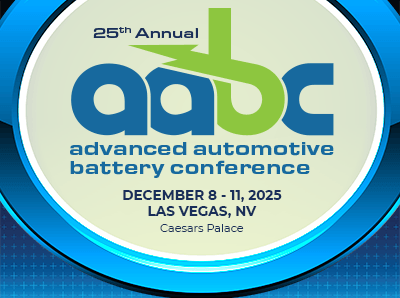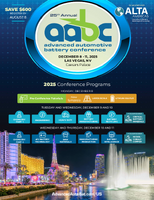2025年度のチュートリアル*
Monday, December 8, 2025 8:00 - 9:30 am
TUT1: Global EV Market Demand: In-Depth Insights, Future Projections, and the Impact on the Battery Supply Chain
Global EV Market Demand: In-Depth Insights, Future Projections, and the Impact on the Battery Supply Chain
Viktor Irle, Co-Founder & Market Analyst, EV Volumes
This interactive tutorial will provide a comprehensive analysis of the latest data and trends in the EV industry. You’ll gain insights into top-selling models, identify the countries and regions leading in EV adoption, and understand what the future holds both in the short and long term. Additionally, we will translate these forecasts into actionable insights regarding battery demand, equipping you with a well-rounded understanding of the evolving landscape of electric vehicles. This tutorial is designed to deepen your knowledge and stay ahead in the rapidly changing EV market globally.
INSTRUCTOR BIOGRAPHIES:
 Viktor Irle, Co-Founder & Market Analyst, EV Volumes
Viktor Irle, Co-Founder & Market Analyst, EV Volumes
TUT2: Understanding the Future of Battery Cell Cost & Assessing the Economic Feasibility of Emerging Technologies
Understanding the Future of Battery Cell Cost & Assessing the Economic Feasibility of Emerging Technologies
Varnika Agarwal, Research Analyst, Rho Motion
Edward Keith, Head of Consulting Operations, Benchmark Mineral Intelligence
This tutorial will discuss raw material price volatility and its impact on LIB cell cost. In addition, understanding key cell cost drivers and forecasting cost of traditional LIBs, and exploring the role that recycled material (and legislation) will play in future battery cell cost will be covered. A walkthrough of key emerging technologies-similarities and differences in raw materials and manufacturing and a breaking down cost on a kWh and cell lifetime basis-defining cost competitiveness by application and performance requirements will be discussed as well as LIB cost scenarios-exploring the feasibility of emerging technologies in possible future price environments.
INSTRUCTOR BIOGRAPHIES:
TUT3: Lithium Mining & Methods
Lithium Mining and Methods
Nicolas Grosso, PhD, Director Innovation, Lilac Solutions
Adele Rouleau, Senior Environmental Consultant, Geosyntec Consultants
This tutorial provides a concise overview of the lithium market, covering global demand drivers, key mining regions, and extraction methods including hard rock and brine processes. Participants will gain foundational insight into lithium’s role in the energy transition and emerging trends in sustainable production.
INSTRUCTOR BIOGRAPHIES:
 Nicolas Grosso, PhD, Director Innovation, Lilac Solutions
Nicolas Grosso, PhD, Director Innovation, Lilac Solutions
 Adele Rouleau, Senior Environmental Consultant, Geosyntec Consultants
Adele Rouleau, Senior Environmental Consultant, Geosyntec Consultants
TUT4: Battery Management Systems & Charging
Battery Management Systems
Scott Trimboli, PhD, Professor, Electrical & Computer Engineering, University of Colorado, Colorado Springs
Battery management systems must perform several tasks, including estimating state of charge, state of health, state of power, and state of energy. Various approaches are available to accomplish these goals. This tutorial will give an overview of commonly used methods and discuss some of their individual advantages and disadvantages. Methods based on empirical equivalent circuit models will be highlighted, but methods using physics-based models will also be introduced.
INSTRUCTOR BIOGRAPHIES:
 Scott Trimboli, PhD, Professor, Electrical & Computer Engineering, University of Colorado, Colorado Springs
Scott Trimboli, PhD, Professor, Electrical & Computer Engineering, University of Colorado, Colorado Springs
Monday, December 8, 2025 10:00 - 11:30 am
TUT5: Cell & Pack Design
Cell & Pack Design for xEVs
Kevin Konecky, Vice President, Battery Systems Engineering, Spiro
This tutorial will give an overview of battery systems design. An overall product development process will be discussed for a typical system. Design aspects of each individual subsystem will be explored with cost impacts of different design choices. Testing, validation, and designing for safety will be other key areas of discussion.
INSTRUCTOR BIOGRAPHIES:
 Kevin Konecky, Vice President, Battery Systems Engineering, Spiro
Kevin Konecky, Vice President, Battery Systems Engineering, Spiro
TUT6: AI for Battery Applications
Battery Intelligence: Non-Obvious but Useful Battery Metrics and Analyses
Tal Sholklapper, PhD, CEO & Co-Founder, Voltaiq, Inc.
In our work across the battery industry, we’ve observed a gap in understanding around key battery metrics and analyses. These are often second nature to long-time battery engineers and electrochemists or considered best practices within a specific battery vertical or lifecycle stage-but are actually applicable more broadly. In this tutorial, we’ll review these non-obvious but useful battery metrics and analyses through interactive demonstrations and discussion. We'll also explore how they can be applied to day-to-day engineering through advances in data science, machine learning (ML), and artificial intelligence (AI).
INSTRUCTOR BIOGRAPHIES:
 Tal Sholklapper, PhD, CEO & Co-Founder, Voltaiq, Inc.
Tal Sholklapper, PhD, CEO & Co-Founder, Voltaiq, Inc.
TUT7: Technology Innovation in the Chinese Battery Industry
Technology Innovation in the Chinese Battery Industry
Shmuel De-Leon, CEO, Shmuel De-Leon Energy Ltd.
This training incorporates Shmuel De-Leon`s review of new Chinese innovative technologies presented during 2024-2025.The motivation behind the training is to provide attendees with the knowledge of China's new technology market trends as China is the larger player on battery materials, cells, and battery-pack manufacturing.
TOPICS TO BE COVERED:
- Nano-Silicon Anodes
- Manganese Rich Cathodes (Mn-Rich)
- Porous Current Collectors
- Composite Current Collectors
- 18650, 21700, 46800, 60mm Cylindrical Cells, Including 21700 and 32140 Tabless Cells
- Na-Ion (Sodium-ion) Cells
- LMFP Cells Semi-Solid & Solid-State Cells
- Lithium Sulfur Cells
- Lithium Metal with Liquid Electrolyte Cells
- High Capacity Prismatic LFP Cells
- Fast Charging LFP Cells
- High Charging Voltage LCO Cells (4.5-4.6V)
- Wide Temperature Operational Cells
- Primary Cells
INSTRUCTOR BIOGRAPHIES:
 Shmuel De-Leon, CEO, Shmuel De-Leon Energy Ltd.
Shmuel De-Leon, CEO, Shmuel De-Leon Energy Ltd.
TUT8: Economics of Battery Material Development & Manufacturing
Technoeconomic Analysis: Effective Development and Commercialization Pathways for New Battery Technologies
Thomas D. Gregory, Owner and Consultant, Borealis Technology Solutions LLC
This tutorial will cover factors that impact successful commercialization of battery materials, technological feasibility vs. economic practicality, and market need/company capability intersection, as well as technoeconomic analysis methodology, focusing on the critical early stages of a project where product design and process chemistry and development occur amid significant technical and economic uncertainty.
INSTRUCTOR BIOGRAPHIES:
 Thomas D. Gregory, Owner and Consultant, Borealis Technology Solutions LLC
Thomas D. Gregory, Owner and Consultant, Borealis Technology Solutions LLC
Monday, December 8, 2025 1:00 - 2:30 pm
TUT9: Solid-State Batteries
Solid-State Batteries
Venkataraman Thangadurai, PhD, Chair, Energy & Faraday Institution; Adjunct Professor, School of Chemistry, University of St. Andrews
In this tutorial lecture, the development of state-of-the-art solid-state Li-ion and Na-ion electrolytes for all-solid-state batteries with an emphasis on ionic conductivity and chemical and electrochemical stabilities, will be discussed.
INSTRUCTOR BIOGRAPHIES:
 Venkataraman Thangadurai, PhD, Chair, Energy & Faraday Institution; Adjunct Professor, School of Chemistry, University of St. Andrews
Venkataraman Thangadurai, PhD, Chair, Energy & Faraday Institution; Adjunct Professor, School of Chemistry, University of St. Andrews
TUT10: Global Battery Passport Programs: Carbon Footprint & Critical Mineral Traceability
Global Battery Passport Programs: Carbon Footprint & Critical Mineral Traceability
Varun Agarwal, PhD, International Transportation Lead, ORISE Fellow, U.S. Department of Energy
Jarod Kelly, PhD, Principal Energy System Analyst, Argonne National Laboratory
Frank Menchaca, Consultant, Libridge
David Roberts, Executive Director, Libridge
Michael Wang, PhD, Group Center Director & Distinguished Fellow, Systems Assessment Center, Argonne National Laboratory
Jingyi Zhang, PhD, Energy System Analyst, Argonne National Laboratory
Several countries have been developing requirements of carbon footprints and critical mineral traceability of automotive traction batteries under the so-called battery passports. With Department of Energy support, Argonne National Laboratory has been evaluating the life-cycle analysis (LCA) approaches of different battery passport programs, while Li-Bridge has been working with the International Society of Automotive Engineers to evaluate and develop battery traceability standard under the SAE. These efforts help US companies in their competitiveness in global battery pack export and impact.
The tutorial session will consist of three presentations:
- Review and evaluation of different battery passport programs in several countries
- Li-Bridge’s activities to support companies in meeting traceability and CI requirements
- SAE battery traceability standard committee’s SAE battery traceability standards
INSTRUCTOR BIOGRAPHIES:
 David Roberts, Executive Director, Libridge
David Roberts, Executive Director, Libridge
 Michael Wang, PhD, Group Center Director & Distinguished Fellow, Systems Assessment Center, Argonne National Laboratory
Michael Wang, PhD, Group Center Director & Distinguished Fellow, Systems Assessment Center, Argonne National Laboratory
 Jingyi Zhang, PhD, Energy System Analyst, Argonne National Laboratory
Jingyi Zhang, PhD, Energy System Analyst, Argonne National Laboratory
TUT11: Battery Recycling: Market & Methods
Battery Recycling: Market & Methods
Steve Sloop, PhD, President, OnTo Technology LLC
By 2030 the battery manufacturing industry is on course to reach $120 billion worldwide. However, with so many uncertainties, the recycling market has projections of $14 to $40 billion. Recycling must be economically sustainable with future $10/kg cathodes, can it achieve such a goal? A supportive recycling industry will be expected to (1) operate with end-of-life batteries as an asset (2) produce cost-competitive elements, electrodes, or electrode precursor materials, (3) safely address large-scale throughputs, and (4) accommodate low cobalt or no cobalt cathode formulations. This tutorial will comprehensively address technologies of pyrometallurgy, hydrometallurgy, hybrid approaches, and direct recycling. The instructor will introduce these and discuss them in light of cost goals and market realities.
INSTRUCTOR BIOGRAPHIES:
 Steve Sloop, PhD, President, OnTo Technology LLC
Steve Sloop, PhD, President, OnTo Technology LLC
TUT12: In-Depth Analysis of the Chinese xEV Battery Industry
In-Depth Analysis of the Chinese xEV Battery Industry
Mark Lu, PhD, Senior Industrial Analyst, Industrial Economics & Knowledge Center, Industrial Technology Research Institute
As the world’s biggest EDV market, Chinese xEV industry has become the most important pioneering target. However, specially planned economy, localized regulations, and multiple business models exist and make international companies’ decision-making more difficult. Therefore, this tutorial will try to provide a whole picture of the Chinese EDV battery market, including policies and regulations, future forecasts, competitive analysis, battery technology strategies, upstream supply chain, and positioning for foreign enterprises.
INSTRUCTOR BIOGRAPHIES:
 Mark Lu, PhD, Senior Industrial Analyst, Industrial Economics & Knowledge Center, Industrial Technology Research Institute
Mark Lu, PhD, Senior Industrial Analyst, Industrial Economics & Knowledge Center, Industrial Technology Research Institute
Monday, December 8, 2025 3:00 - 4:30 pm
TUT13: Improving the Energy Density of Batteries with Silicon-Based Anodes
Improving the Energy Density of Batteries with Silicon-Based Anodes
Dee Strand, PhD, CSO, R&D, Wildcat Discovery Technologies, Inc.
The key challenges in the use of silicon-based anodes, as well as progress in the implementation of silicon and what can we expect in the future. The latest improvements in other battery components are required to maximise the benefit of silicon-based anodes.
INSTRUCTOR BIOGRAPHIES:
 Dee Strand, PhD, CSO, R&D, Wildcat Discovery Technologies, Inc.
Dee Strand, PhD, CSO, R&D, Wildcat Discovery Technologies, Inc.
TUT14: Li-ion Battery Safety & Thermal Runaway
Li-ion Battery Safety & Thermal Runaway
Ahmad Pesaran, PhD, Chief Energy Storage Engineer, National Renewable Energy Laboratory
Application of lithium-ion batteries (LIB) in electrified transportation and renewable grid is growing at a very fast pace for decarbonization of the passenger vehicles by 2035. Due to the characteristics of current LIB technologies, although rare, there is potential for thermal runaway and fires, as seen by recent fires in Tesla Model S, Chevy Bolt, and grid storage system in an Arizona Utility. Increased severity of fire incidents with more advanced energy-dense LIBs, especially cathodes with higher Ni, and anodes with silicon or lithium, is expected.
In this tutorial/seminar we will: 1.) discuss fundamental causes for safety issues leading to thermal runway and fire, 2.) review abusive behavior of cells and packs through characterization, testing, and modeling/simulations, 3.) provide overview of approaches that could reduce safety risks and detect impending failures, and 4.) provide references as a resource for accessing more information.
This tutorial/seminar is provided by Dr. Ahmad Pesaran with 25+ years’ experience in lithium-ion battery R&D including safety testing and modeling with perspectives of his participation at USABC Technical Advisory Committee. He will provide the audience with information and understanding needed to handle Li-ion battery safety in both their work at their companies and in products they deliver to the market.
TOPICS TO BE COVERED:
- LIB Applications LIB Introduction
a. Battery Fundamentals
b. Battery Chemistries
c. Cell Designs - LIB Safety and Abuse
a. LIB Fires
b. Instigators for Thermal Runaway
c. Battery Abuse Characterization and Testing Equipment
d. Battery Abuse Modeling/Simulation Tools - Approaches for Designing Safer Cells and Modules-Recent Progress of EV Pack and System Safety
- Remarks on Safe Handling of LIBs Summary
INSTRUCTOR BIOGRAPHIES:
 Ahmad Pesaran, PhD, Chief Energy Storage Engineer, National Renewable Energy Laboratory
Ahmad Pesaran, PhD, Chief Energy Storage Engineer, National Renewable Energy Laboratory
TUT15: Li-ion Cell Design & Manufacturing
Li-ion Cell Design & Manufacturring
James Kaschmitter, CEO, SpectraPower LLC
This tutorial will begin with an overview of Li-ion cell design for performance and manufacturability, including contrasting the performance and characteristics of commonly used materials. The tutorial will then lead to a detailed review of Li-ion cell manufacturing, from incoming raw materials through final cell formation, aging, and shipment.
INSTRUCTOR BIOGRAPHIES:
 James Kaschmitter, CEO, SpectraPower LLC
James Kaschmitter, CEO, SpectraPower LLC
TUT16: The Rechargeable Battery Market Value Chain and Main Trends: 2025-2035
The Rechargeable Battery Market Value Chain & Main Trends: 2025-2035
Christophe Pillot, PhD, Director, Avicenne Energy
Michael Sanders, Senior Advisor, Energy, Avicenne Energy
ABOUT THIS TUTORIAL:
This tutorial will present the 10-year automotive market forecasts from Avicenne and other analysts (micro/Hybrid/P-HEV/EV). Other coverage will include car makers’ strategies and advanced energy storage (advanced lead acid/supercap/NiMH/LIB). Additionally, LIB design for P-HEV & EV markets (cylindrical, prismatic, pouch/wounded, stacked, Z fold cells) and LIB cell, module, and pack cost structure will be discussed.
TOPICS TO BE COVERED:
- The rechargeable battery market in 2025
- Battery market by application
- Electronic devices, xEV, e-bikes, power tools
- Stationary applications
- Raw materials for lithium-ion battery supply chain
- Battery market forecasts, 2025-2035
- Focus on xEV market
- OEM supply chain
- xEV forecasts
- Impact of Li-ion batteries on lead acid battery market
- Conclusions
INSTRUCTOR BIOGRAPHIES:
 Christophe Pillot, PhD, Director, Avicenne Energy
Christophe Pillot, PhD, Director, Avicenne Energy
 Michael Sanders, Senior Advisor, Energy, Avicenne Energy
Michael Sanders, Senior Advisor, Energy, Avicenne Energy
*All Access or separate registration required for Tutorials
*不測の事態により、事前の予告なしにプログラムが変更される場合があります。
イベント情報更新
講演者・スポンサー更新
講演者・スポンサー更新
























